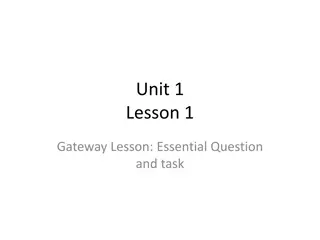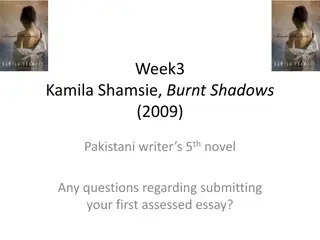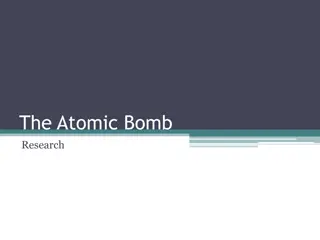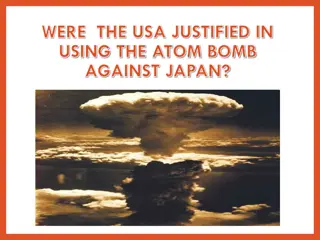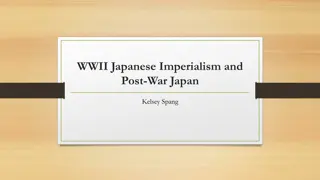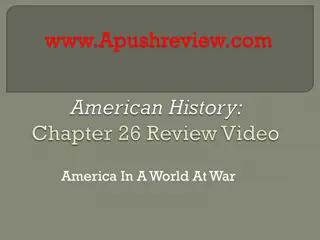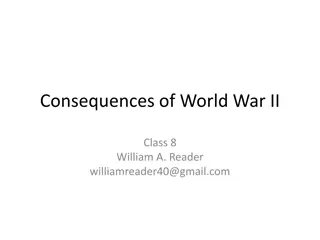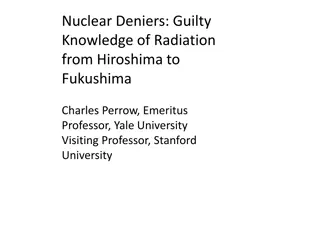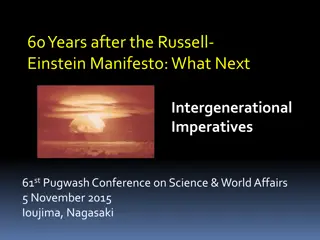World War 2 Key Events and Operations
World War 2, spanning from 1939 to 1945, saw significant events like the invasion of Poland, Operation Barbarossa, D-Day landings, and the conclusion with V-E and V-J Days. Operations such as Dieppe (Operation Jubilee) in 1942 taught crucial lessons in military strategy and coordination. The Atlanti
2 views • 38 slides
Exploring Nuclear Shadows in History: Uncovering WWII Motivations
Dive into the harrowing history of nuclear shadows and the devastating impact of the bombings in Hiroshima and Nagasaki during World War II. Discover the unanswered questions surrounding these events and embark on a journey to understand the political, economic, and social motivations that drove the
0 views • 27 slides
Exploring Themes in Kamila Shamsie's Burnt Shadows
Kamila Shamsie's fifth novel, Burnt Shadows, delves into the impact of war on love, loss, and human relationships across decades and continents. Through the stories of two families and the aftermath of the Nagasaki bombing, Shamsie challenges notions of nationhood, human cost of conflicts, and the e
0 views • 12 slides
Understanding the Atomic Bombings of Hiroshima and Nagasaki
Explore the events leading up to and following the dropping of atomic bombs on Hiroshima and Nagasaki, including key dates, casualties, bomb effects, and the ongoing debate on the justification of using such weapons. Dive into the destructive power, heat, and blast effects of atomic bombs, shedding
0 views • 28 slides
The Atomic Bombings of Hiroshima and Nagasaki: Justification and Consequences
The United States justified the use of the atomic bomb against Japan in WWII to expedite the end of the war and save American lives, leading to the devastating bombings of Hiroshima and Nagasaki. President Truman's decision and its aftermath sparked debates on ethics, morality, and the human cost of
0 views • 10 slides
WWII Japanese Imperialism and Post-War Japan
Explore the historical narrative of WWII Japanese imperialism, the factors leading to Japanese control of Pan-Asia, interference from the West, rational for Pearl Harbor, and the aftermath including the fall of Japan and the devastating effects of the atomic bombs on Hiroshima and Nagasaki.
0 views • 17 slides
World War II: America's Impact and Legacy
The content discusses various aspects of America's involvement in World War II, including key events, societal changes, technological advancements, and the impact on different communities such as African Americans, Native Americans, and Japanese Americans. It also touches upon significant moments li
0 views • 8 slides
The Impact of World War II on Japan and the Emergence of the Cold War
World War II had far-reaching consequences on Japan, leading to significant naval battles, intense fighting in Okinawa, and ultimately, the country's surrender following the atomic bombings of Hiroshima and Nagasaki. The post-war period saw the emergence of the Cold War as tensions rose between the
0 views • 63 slides
Guilty Knowledge of Radiation: From Hiroshima to Fukushima
The article discusses the history of radiation exposure from nuclear events such as the bombings of Hiroshima and Nagasaki to incidents in various countries' nuclear facilities. It highlights the contrasting beliefs about the effects of low-level radiation exposure among nuclear scientists and genet
0 views • 46 slides
Reflections on the Intergenerational Imperatives of the 61st Pugwash Conference
In the aftermath of the Russell-Einstein Manifesto, the 61st Pugwash Conference convened in Nagasaki to discuss intergenerational imperatives in the pursuit of peace and scientific cooperation. The session aimed at preserving memory, sharing stories, and igniting action through the insights of figur
0 views • 14 slides

